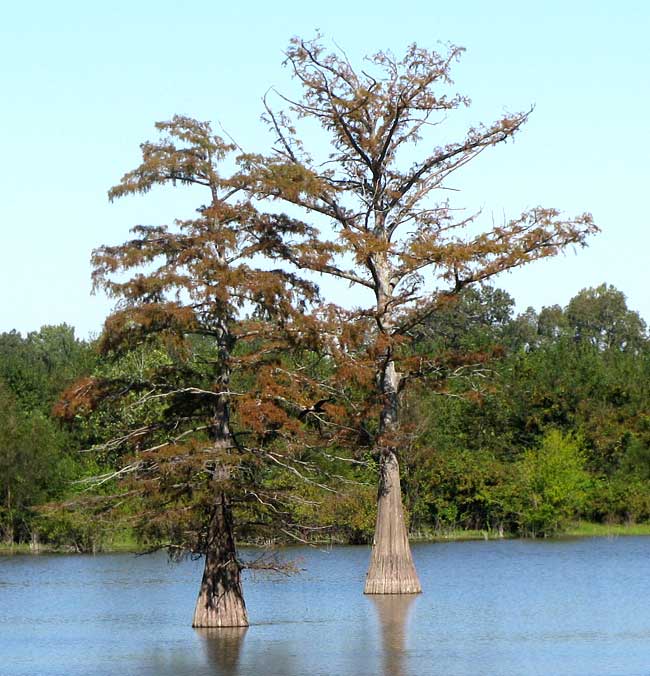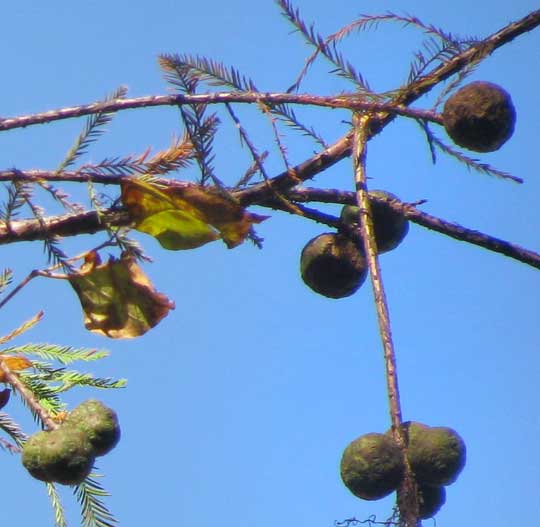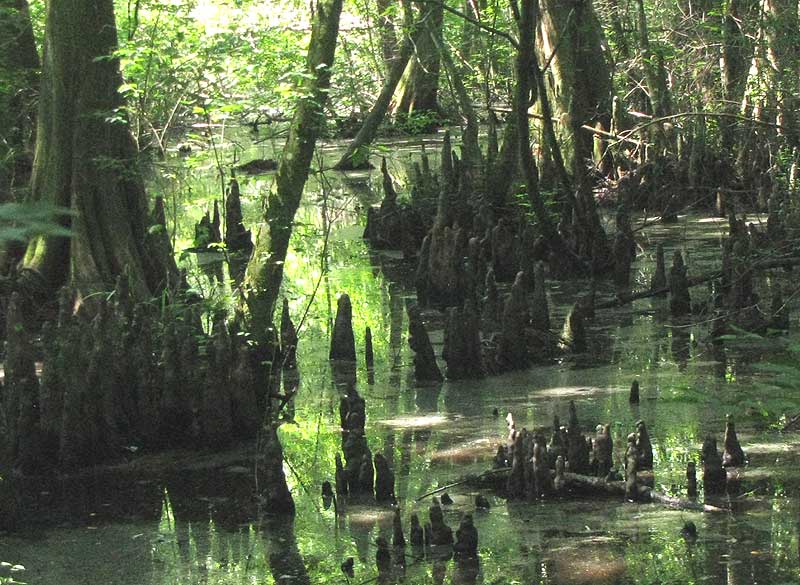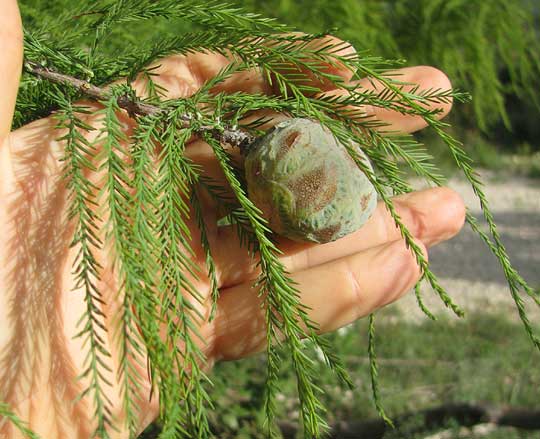Excerpts from Jim Conrad's
Naturalist Newsletter

from the the November 1, 2009 Newsletter, from near Natchez, Mississippi
BALDCYPRESSES IN THORNBURG LAKE
Thornburg Lake is a locally famous fishing spot in Anna's Bottom, at the end of a Pecan-tree bordered, one-lane gravel road that first passes across big fields of cotton and soybeans, then through bottomland forest. The lake is shallow and here and there all the way across it Baldcypress trees, TAXODIUM DISTICHUM, rise like ships from the water, as shown above.
The trees' leaves are brown because Baldcypresses, despite being gymnosperms like pines and spruces, are deciduous, and it's time for leaves to fall. It's also time for the trees to bear fruits. You can see both the trees' feathery leaves and spherical fruits below:

I'll bet that several folks who know their trees are looking at the above pictures wondering whether, with those oversized trunks for such short trees, and light gray bark, those might not really be Pondcypresses. Some field guides recognize Pondcypresses as a separate species, Taxodium ascendens*. The Flora of North America, however, relegates Pondcypresses to varietal status, Taxodium distichum var. imbricarium, plus the distribution map for the variety places southwest Mississippi outside its range.
I don't know what the Pondcypress deal is in this area but I do know I love Baldcypresses. In the western Kentucky bottomlands in which I grew up I was surrounded by "cypress swamps," the nearby stream was "Cypress Creek," and to me no ecosystem was more interesting and exciting than wherever Baldcypresses showed up. When I waded into them I always saw species of waterfowl, aquatic mammals, snakes, insects, spiders and the like not found elsewhere. Just thinking of Baldcypresses evokes for me a feeling of discovery and adventure.
from the May 27, 2012 Newsletter, from near Natchez, Mississippi
CYPRESS KNEES
The other day I was in a swamp with Baldcypresses growing in standing water. It was a beautiful place and I just sat for a long time watching dragonflies dart about, bubbles gurgle up from the mud, breezes giving this or that leaf a momentary shudder. You can see the scene before me below:

All my life I've read, and passed on the information, that those knobby items projecting from the water -- "cypress knees" -- are pneumatophores supplying oxygen to the trees' submerged roots. Baldcypresses planted on dry land don't produce them.
Now I learn that studies haven't been able to prove this assumption. In fact, laboratory tests demonstrate that Baldcypress knees are ineffective at depleting oxygen in a sealed chamber. Also it's known that swamp-dwelling Baldcypresses having their knees removed continue to thrive without them.
So, really it's unclear what purpose Baldcypress knees serve. The only thing that's certain about them is that in a swamp they lend an air of majesty with their mere presence.
from the October 14, 2012 Newsletter issued from the valley of the Dry Frio River in northern Uvalde County, southwestern Texas, on the southern border of the Edwards Plateau; elevation ~1750m (~5750 ft); N29.62°, W99.86°; USA
BALDCYPRESS IN SOUTHWESTERN TEXAS
I've always associated Baldcypress, TAXODIUM DISTICHUM, with swamps, bayous and big, slow-moving rivers, so before arriving in arid southwestern Texas I was surprised to read on a Texas A&M webpage that Baldcypresses "... can be found along river beds and wet areas of the Edwards Plateau and South Texas Plains." We're exactly where the Edwards Plateau meets the Coastal Plain, so Baldcypresses should be here. And they are, as shown below:

That picture shows a Baldcypress' cone-type fruit at the tip of a branch from which also arise drooping branchlets on which many green, slender leaves grow. In other words, the "green feathers" in the picture are not dangling compound leaves, but rather branches bearing many short, slender, needlelike leaves.
Though the literature is clear about Baldcypress being native to this area's river beds, I'm told that the trees along the little Dry Frio River behind the cabin were planted some years ago, and that naturally occurring Baldcypresses aren't found here. I suspect that that's true, the tree's wonderful wood having doomed the species to extermination in this area by loggers wanting the wood. I also hear that along other local rivers some very large, old Baldcypresses remain.
Baldcypress' taxonomy has always been a mess. Nowadays what we used to call the Pondcypress is lumped into the Baldcypress species. The online Flora of North America recognizes three varieties, with the species distributed from North America through Mexico into Guatemala. In Texas other names used for the species include Black Cypress, White Cypress, Yellow Cypress, Red Cypress, Gulf Cypress, Southern Cypress, Swamp Cypress and Sabino-Tree.